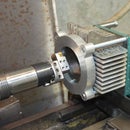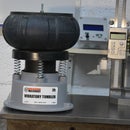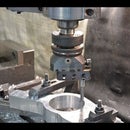Introduction: Tool Demagnetizer and Magnetizer
Tools sometimes get magnetised, this can be both useful and undesirable depending on the type of tool and the actual job that you want to use it for. For example there are times when having a magnetised screw driver is helpful to hold a screw when you need to put it in an awkward place but unless you want to do that it can be a disadvantage because it will attract any ferrous swarf, nails and screws nearby. Drill bits are a tools which you would not want to ever be magnetised, it will get covered in chips when drilling ferrous material.
That said, we can see that a means to magnetise and demagnetise tools and other objects like vernier calipers would be a useful workshop addition. To magnetise a tool we only need subject it to a strong uni-directional magnetic field and to demagnetise we subject the object to an alternating magnetic field.
DIY tool demagnetisers, mostly use mains power in one form or another to get an alternating magnetic field. For many years I have used a modified transformer to both magnetise and demagnetise tools. It has worked well in each mode. I feed it with AC current for demagnetising and DC to create a magnetised tool.
However, recently Mark Presling posted an ingenious demagnetiser on the HomeMadeTools forum which did not connect to any electrical supply, see here http://www.homemadetools.net/forum/diy-demagnetising-tool-works-72881
Yesterday was a big family celebration with much eating and drinking, which kept me out of my workshop most of the time. I got free around 20:00 and I went for a quick fix. As I did not have much time I wanted something that I could start and finish in an hour or so and Mark's device came to mind.
Step 1: Materials and Tools
As with most maker projects it is the idea that is important not so much the construction detail. A project can be replicated in many different ways depending on the materials and tools available to the individual maker, so the following is what I used with the tools that I have. Remember that you do not have to follow to the letter my own construction and there are different tools that could be used. Just take the ideas and run with it.
Materials
- A piece of aluminium bar, mine was a small casting from the scrap box.
- A 13 mm length of 50 mm Delrin bar.
- Four rare earth button magnets, 12 mm diameter for the demagnetiser.
- Two longer (25 mm) bar magnets or a stack of button magnets for the magnetiser. As shown above.
- Tube of super glue.
Tools
- Lathe, with turning and boring tools.
- Milling machine, with 12 mm end mill for the magnet recesses.
Step 2: Demagnetiser
The principle behind this system is to make a device which presents to the tool, being demagnetised, an alternating magnetic field. This is achieved by rotating adjacent magnets of opposing polarity.
Any even number of magnets could be used and I chose four. Using more would require a larger diameter device to fit them in.
It did not take long to turn up a piece of scrap aluminium and mill 4 recesses for the magnets. The other side of the block was turned down to 13 mm diam. to fit in a drill press chuck to spin it. The large end was 41 mm diam and 11 mm thick, but these dimensions were dictated by the piece of aluminium at hand and are not critical. This is shown in the above photos, with magnets glued in place. I made it with the magnets a little proud.
Step 3: Plastic Cover
A quick test confirmed Mark's claims that it worked well. However, because the magnets were proud it gave a rough ride to any tool being demagnetised. I was also a little concerned that, in general use, the strong magnets would pluck ferrous swarf, nails, screws etc. from the surroundings, which would be hard to remove properly. To fix both I turned up a cover from some 50 mm Delrin bar which I glued in place. The face part was just over 1 mm thick. I had tested that a 3 mm gap between magnets and tool was close enough to work well so I knew that 1 mm would give no problems with the increased reluctance. The cover was also a safety feature in that it prevents the magnets from being knocked out and becoming missiles.
The magnets can be seen through the 1 mm thick face surface.
Step 4: Cover Tested Early
As it turned out the wisdom of covering the magnets for cleaning reasons became apparent very quickly. Within seconds of fitting the cover I dropped the piece and it rolled under the lathe and came out as shown.
It would have been a pain to clean off exposed magnets but was a simple chore with the cover in place.
Step 5: Using the Demagnetiser
This is simplicity itself.
I mount the device in a drill press chuck, although it could be anything that rotates and a milling machine or lathe are equally suitable. With the device spinning it is just a question of holding the tool, to be demagnetised, against the working face for a few seconds and then slowly withdrawing the tool. It will then be demagnetised.
The photos show a screw driver and pair of calipers being demagnetised. The calipers became magnetised when measuring the magnets used in this project.
Step 6: Magnetiser
Sometimes it is helpful to magnetise tools such as screw drivers etc. to hold screws and other hardware in hard to reach places. I simply feed my transformer based demagnetiser DC in order to do that.
In keeping with the idea of using a "no power required" device for demagnetising I wondered how easy it would be to make a magnetiser the same way. It turned out to be dead easy, it was also a no work device, I did not have to make anything. As the following shows I joined two longitudinally polarised magnets end to end and added a keeper to each end. Then I just put it on the tool, a screwdriver being the example shown, and that's all there is to it. This method does not impart as much magnet effect as my transformer method but quick tests showed that it should be quite adequate for most if not all needs.
Thank goodness for modern magnets, years ago, if you needed to magnetise something like a screwdriver, you would have to stroke the object many times with a magnet to build a significant effect.
PS. I later shaped the ends of the end pieces to fit better on the screwdriver and so reduce magnetic reluctance. This produced a noticeable greater magnetic effect in the tool.
Step 7: Conclusion
This Instructable demonstrates simple devices for magnetising and demagnetising a variety of workshop tools. Its simplicity and handy convenience guarantee that I'll be using this in preference to my old transformer based device.
If I was making it again with the benefit of hindsight, I would have made it all out of Delrin and milled the magnet holes deeper but inserting the magnets from the rear. It would not work any better but would be a nicer solution.
To finish off, I cut out a 1 mm thick steel circle to use as a keeper for the demagnetiser which "shorts" out the magnetic field and completely kills any tendency to collect ferrous swarf. Illustrated above.











